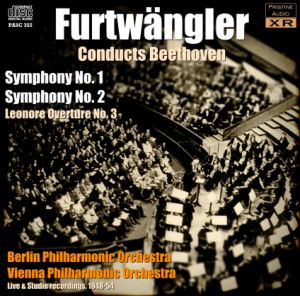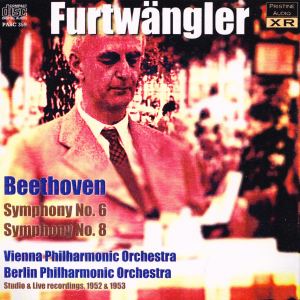 |
 |
| 
|
Ludwig van BEETHOVEN
(1770-1827)
Symphony No. 1 C major, Op. 21 (1799/1800) [24:37]
Symphony No. 2 in D major, Op. 36 (1801/02) [32:25]
Leonora Overture No. 3, Op. 72b (1806) [15:18]
 Berlin Philharmonic Orchestra/Wilhelm Furtwängler (Op.
21)
Berlin Philharmonic Orchestra/Wilhelm Furtwängler (Op.
21)
Vienna Philharmonic Orchestra/Wilhelm Furtwängler (Op. 36,
Op. 72b)
rec. live, 19 September 1954, Titania Palast, Berlin (Op. 21); live,
3 October 1948, Royal Albert Hall, London (Op. 36); 18 October 1953,
Musikvereinssaal, Vienna (Op. 72b)
 PRISTINE AUDIO PASC 355 [72:20]
PRISTINE AUDIO PASC 355 [72:20]
|

|
Ludwig van BEETHOVEN
(1770-1827)
Symphony No. 6 in F major, Op. 68 ‘Pastoral’ (1807/08)
[44:27]
Symphony No. 8 in F major, Op. 93 (1812) [25:45]
 Vienna Philharmonic Orchestra/Wilhelm Furtwängler (Op. 68)
Vienna Philharmonic Orchestra/Wilhelm Furtwängler (Op. 68)
Berlin Philharmonic Orchestra/Wilhelm Furtwängler (Op. 93)
rec. 24-25 September, 1 October 1952, Musikverein, Vienna (Op. 68);
live, 14 April 1953, Titania Palast, Berlin (Op. 93);
 PRISTINE AUDIO PASC 359 [70:12]
PRISTINE AUDIO PASC 359 [70:12] |
| |
This pair of Beethoven releases conducted by Wilhelm Furtwängler
is from the Pristine Audio label who specialise in the restoration
and re-mastering of historic recordings. Restoration engineer
Andrew Rose has carried out the XR re-mastering. In the booklet
notes Rose explains in some detail the variable quality of the
material he had to work with. As far as I know these performances
have been all released previously on other labels and I know
three of the five performances. Bearing in mind the real historic
significance of the Furtwängler performances my criterion
for judging success is being able to enjoy them without the
sound quality intruding too much.
Furtwängler is widely accepted as being one of the greatest
conductors of the twentieth-century. He left a fascinating and
substantial audio legacy including a substantial number of live
events that are cherished by a large and enthusiastic group
of devotees. Much has been written about the sheer individuality
of Furtwängler’s interpretations. There is the sheer
beauty of the sound that he demands, his innate sense of the
music’s structure, the incredible energy produced and
the remarkable emotional intensity generated. Furtwängler’s
conducting has a sense of spontaneity and I am often surprised
at his fluctuating tempi and bold dynamics. Whether or not his
idiosyncrasies are invasive will be very much down to personal
choice.
It might prove useful to have some context for these recordings.
Furtwängler is best known for his association with the
BPO whom he first conducted in December 1917; however he had
long associations with several other orchestras that are often
forgotten. In 1922 he succeeded Artur Nikisch as principal conductor
of the BPO serving in Berlin until his death in 1954, a tenure
that was interrupted between the years 1945-47. The BPO was
almost certainly the world’s most famous orchestra, and
probably still is and right through the Second World War they
served as the cultural flagship of Hitler’s Third Reich.
Blacklisted by the Nazis and fearing arrest Furtwängler
fled to Switzerland in February 1945 a few months before the
end of the war. During his absence Leo Borchard who was Moscow
born of German parents, an obvious favourite of the occupying
Russian forces, was appointed to the post. After only a few
months Borchard with the orchestra was fatally shot by an American
sentry after a misunderstanding at a Berlin check-point. Romania
Sergiu Celibidache became an intermediate appointment as principal
conductor and was in effect keeping the seat warm until Furtwängler
was allowed to return to the BPO. After his successful de-Nazification
process in December 1946 Furtwängler, who was extremely
popular with the majority of the players, was cleared to return.
He began conducting his first concerts in May 1947 returning
officially as the orchestra’s principal conductor in 1950
and remaining until his death in 1954.
Furtwängler was active too as a conductor in Vienna conducting
there as early as 1918 with the Wiener Symphoniker and then
in 1919 with the Tonkünstler-Orchester. Furtwängler’s
close association with the VPO began in 1922 when he conducted
the orchestra for the first time. He succeeded Felix Weingartner
as the regular conductor of the subscription concerts from 1927/30.
When the VPO ceased their single subscription concert conductor
system Furtwängler in effect became the main conductor
serving from 1933 to 1945, and again from 1947 to 1954. Furtwängler
had fixtures with the VPO on more than 500 occasions until August
1954; shortly before he died in November that year.
The first disc Pristine Audio PACD 355 has him conducting the
BPO in Beethoven’s Symphony No. 1, Op. 2, and the
VPO in the Symphony No.2, Op. 36 and Leonora Overture
No.3, Op.72b.
The Symphony No. 1 was recorded live at the Titania Palast
cinema, Berlin. The reason for the choice of a cinema in which
to hold their concerts is an interesting one. On the night of
the 29-30 January 1944 the home of the BPO the (alte) Philharmonie
onBernburger Straße, Berlin was destroyed in a
six hour Allied bombing raid. After this the BPO was forced
to use a variety of temporary venues. Miraculously the Titania
Palast cinema in Berlin remained unscathed throughout the bombing,
and became their principal concert hall for number of years.
On a visit to Berlin back in September I noticed that the Titania
Palast still exists today as multiplex cinema.
Furtwängler played the same programme at the Titania Palast
on 19-20 September 1954. This live recording of the Symphony
No. 1 is from the first of those two concerts. The concert
on 20 September turned out to be Furtwängler’s last
ever appearance on the concert stage. This was ‘big band’
Beethoven with Furtwängler presiding over a weighty and
commanding performance. The deep resonance of the low strings
typically underpins the playing with a rich tonal power. Furtwängler’s
forceful reading of the restless Menuetto was strikingly
direct. Forthright and jubilant the assured drama of the Finale
left an intensely satisfying impression. After becoming accustomed
to the bright sound quality I hardly felt distracted from the
performance. I noted that no applause was left in at the end
of any of the five works featured on these two discs.
The Symphony No.2 with the touring VPO was recorded live
on the 3 October 1948 at the Royal Albert Hall, London. This
was Furtwängler’s only known recording of the Symphony
No.2 and was discovered as late as 1979. Using often furious
speeds in the opening movement Furtwängler mixes a rich
palette that splendidly displays the glories of the Vienna orchestra.
An uplifting picture of Alpine vistas is revealed in the Larghetto
and there’s a frequently mischievous Scherzo. There’s
a fresh and squally quality to the joyous yet frequently tempestuous
Finale. From 1948 this is the oldest recording on the
two releases and presents the most challenging sonics. My ears
soon became attuned to the sound quality.
The Leonora Overture No.3 was recorded by Furtwängler
and the VPO under studio conditions on 18 October 1953 at the
Musikvereinssaal, Vienna. This highly charged and distinctive
interpretation is overflows with exhilaration. No problems whatsoever
with the sound. It comes over splendidly for its sixty years.
The second disc on Pristine Audio PASC 359 comprises Furtwängler’s
recordings of symphonies 6 with the VPO and 8
with the BPO.
He recorded this uplifting and very beautiful Pastoral
with the VPO under studio conditions at the Musikvereinssaal,
Vienna on 24-25 September and 1 October 1952. The judiciously
controlled opening movement entitled ‘Awakening of
cheerful feelings upon arrival in the country’ evokes
long and warm summer days in the countryside. Relatively unforced
and affectionate the Andante ‘By the brook’
is followed by the gloriously appealing Allegro ‘Happy
gathering of country folk’ notable for the woodwind
and brass figures. The fourth movement Allegro ‘Thunderstorm;Storm’
is powerful and unsettling - almost frightening in its intensity.
The Allegretto: Finale ‘Shepherds' song;
cheerful and thankful feelings after the storm’
is splendidly atmospheric, conveying a captivating sense of
redemption. The studio sound felt satisfying providing no real
distraction from the music-making.
For Symphony No. 8 Furtwängler conducts the BPO
live at the Titania Palast, Berlin on 14 April 1953. There is
a powerful and deeply resonant feel to the opening of the first
movement Allegro vivace e con brio. I was able to visualise
a magnificent Alpine scene as if viewing from a snow-capped
mountain peak. Neither a Scherzo nor a slow movement,
the second movement is good-humoured and joyous yet a sense
of volatility is never far away. The surprisingly weighty Menuetto
seems to strive for a stately character without achieving complete
success. The complex Finale with its lengthy and mighty
Coda is highly charged and swells with optimism. I can
report good sound quality with nothing to divert the attention
too much.
Pristine Audio has done a marvellous job with these Beethoven
transfers which should prove indispensable for Furtwängler
admirers.
Michael Cookson
Masterwork Index: Beethoven Symphony
1 ~~ Symphony
2 ~~ Symphony
6 ~~ Symphony
8
|
|

